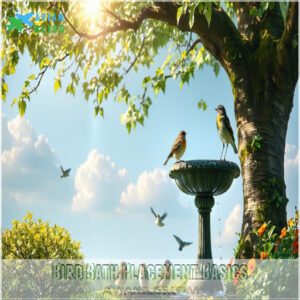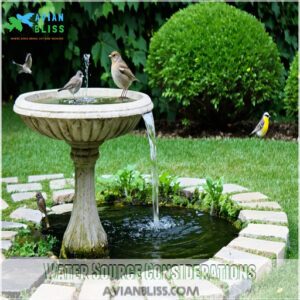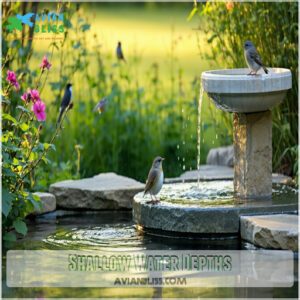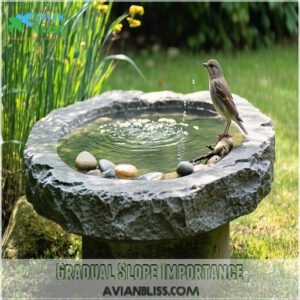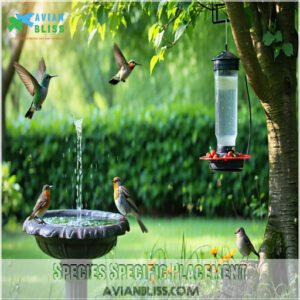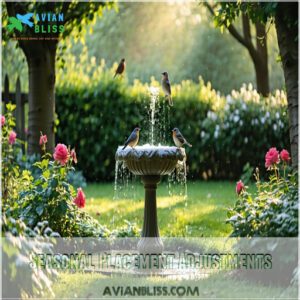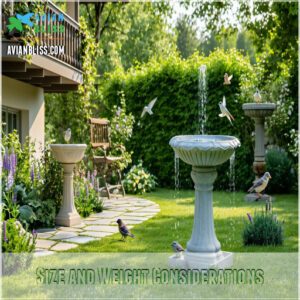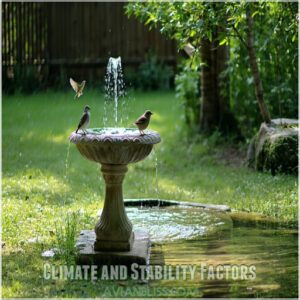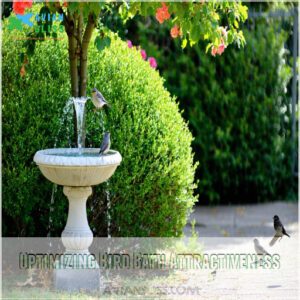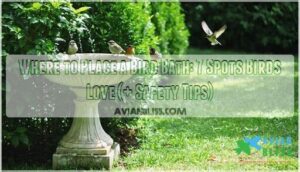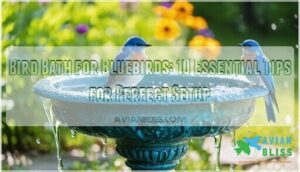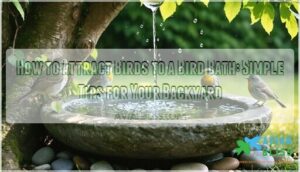This site is supported by our readers. We may earn a commission, at no cost to you, if you purchase through links.

Keep it near shrubs or low trees for safety, but leave at least 6-10 feet of open space to watch for sneaky predators like cats.
Skip windy areas to avoid spills, and choose a quiet corner away from noisy distractions.
Adding movement, like a bubbler, makes it extra appealing, and make sure it’s easy for you to clean and refill too.
With the right setup, you’ll soon have feathered visitors flocking in—time to explore what designs might work best!
Table Of Contents
- Key Takeaways
- Bird Bath Placement Basics
- Water Source Considerations
- Bird Bath Design Essentials
- Species Specific Placement
- Seasonal Placement Adjustments
- Choosing Ideal Locations
- Optimizing Bird Bath Attractiveness
- Frequently Asked Questions (FAQs)
- Where to put a bird bath?
- How do you make a bird bath more attractive?
- How to install a birdbath?
- How do I get my bird bath started?
- How to choose a bird bath?
- Why is bird bath placement important?
- Where should bird baths be placed?
- Should a birdbath be in the sun or shade?
- Why are birds not using my birdbath?
- How far away from the house should a bird bath be?
- Conclusion
Key Takeaways
- Pick a spot with partial sun and shade to keep water cool and comfortable for birds.
- Place the bird bath near shrubs or low trees for safety, but keep a 6-10 foot distance to avoid predator hideouts.
- Add moving water features like a bubbler or dripper to attract birds and prevent stagnation.
- Make sure the bath is easy to clean and refill, keeping water fresh and safe for visitors.
Bird Bath Placement Basics
Placing your bird bath in the right spot makes all the difference for attracting feathered visitors.
Look for areas that balance sun and shade, stay clear of strong winds, and offer nearby cover for safety.
Sunlight and Shade Balance
Balancing sunlight and shade is key for ideal bird bath placement.
Birds often prefer spots with partial sunlight and shade patterns that regulate water temperature.
Too much light intensity causes overheating, while persistent shade may leave water cold.
Place the bath where sunlight hits in the morning but shade cools it later—great for thermal regulation and photoperiod effects!
Wind and Open Spaces
Position bird baths in spots with gentle air flow, not strong gusts.
Too much wind can spill water and scare birds off.
Use trees, fences, or shrubs as wind barriers to reduce turbulence.
Open area design helps birds feel safe with clear flight paths.
For solid air flow management, focus on space optimization to shield against wind without blocking access.
Noise Level Considerations
Too much noise can scare birds away, so pick a spot where sound pollution is minimal.
Quiet zones near bushes or trees provide comfort and safety, use natural audio barriers, like shrubs, as sonic shields against traffic or loud neighbors.
Lower noise levels help birds relax and visit often—a key for successful bird bath placement tips and an ideal location!
Safe Heights and Locations
Bird bath placement isn’t just random – it’s about smart height considerations.
Elevated positions (2-3 feet) help with predator deterrents, giving birds a sense of security.
Avoid spots near shrubs where cats can lurk.
Mix safe zones with clear escape paths.
These location strategies make bird bath safety tips simple: think height, openness, and visibility for effective bird bath predator protection.
Water Source Considerations
You’ll want to keep your bird bath close to a water source to make refilling and cleaning easier.
Moving water also helps attract birds, so consider adding something like a small pump or fountain to keep it fresh and inviting.
Options for Water Supply
When setting up your bird bath, the water source matters more than you’d think!
Here are four ideas to keep things fresh and flowing:
- Use Water Pumps to keep it circulating.
- Try Rainwater Harvesting for an eco-friendly option.
- Install Filtration Systems to maintain great water quality.
- Consider Plumbing Options for easy refills.
For convenient water circulation, explore a bird bath pump product selection.
Birds will love it!
Cleaning and Maintaining Water
To keep your bird bath safe and inviting, clean it regularly with simple tools like brushes and eco-friendly cleaning supplies.
Scrub grime away, rinse thoroughly, and refill with a fresh supply of water.
Bacterial control is key—vinegar works wonders, Avoid harsh chemicals.
For extra finesse, consider filtration systems.
Consistent bird bath maintenance guarantees happy birds and healthier spaces.
Preventing Stagnant Water
Stagnant water’s like an open invite for mosquitoes and algae.
Use aeration methods like a Water Wiggler to keep things moving—it’s great for bird bath maintenance.
For extra bacterial control, clean the bird bath weekly.
Keep the water circulating; even a small pump works wonders.
Healthy water means happy birds and fewer worries for you!
By incorporating a bird friendly habitat in your yard, you can attract a variety of bird species to enjoy your bird bath, creating a bird friendly environment with happy birds and a healthy water system.
Bird Bath Design Essentials
You’ve got to pick the right design if you want birds to safely enjoy your bird bath.
This design should include shallow water, a gentle slope, and a textured base.
These features make it easy for birds to drink, bathe, and keep their footing.
Shallow Water Depths
A shallow birdbath is a must—birds love water that’s safe, not a mini-ocean.
Aim for water depth under two inches for Depth Safety, making it easier for Bird Hydration and splashing around.
Use Shallow Pools or rocks to tweak the bird bath water level.
Good Water Edge Design guarantees everyone, even tiny birds, enjoys their drink.
Considering the importance of Shallow Bird Baths can greatly enhance the overall bird bath experience, focusing on Shallow Pools.
Gradual Slope Importance
A gradual slope in your bird bath design isn’t just a nice touch—it’s essential for Bird Safety and Bath Accessibility.
Birds love a Gentle Incline, letting smaller species dip their feet confidently.
A smart Slope Design guarantees natural Water Flow, avoiding stagnant pools.
The ideal bird bath should incorporate a proper Bird Bath Slope to prevent accidents.
Follow this bird bath placement guide to make your bath safe, functional, and a feathered favorite!
Textured Base Benefits
A textured base isn’t just fancy talk—it’s about giving birds solid footing.
Choose rough surfaces like stone or concrete for excellent slip resistance and bird grip.
Avoid smooth materials that become slick when wet.
Safety features like a gritty bottom prevent slips during splashing.
It’s one small tweak in your bird bath setup that guarantees their comfort and safety.
Species Specific Placement
Different bird species have unique preferences, so placing your bird bath in the right spot can make all the difference.
Whether it’s robins who love a ground-level bath or hummingbirds that prefer nearby perches, understanding their needs helps attract them.
Robin and Hummingbird Preferences
Robins love a shaded spot with shallow water for secure footing, while hummingbirds flock to misty features like misters or bubblers.
Add slim branches nearby for feather care and bird perches.
Keep the bird bath placement away from predators but visible, and note that bright reds near hummingbird bird baths help too.
Hummingbirds are also attracted to moving water features that mimic their natural habitat, which is a key aspect of creating an ideal bird bath location, and that’s how you nail an ideal bird bath location with the right moving water features.
Chickadee and Oriole Needs
For chickadees, place their bird bath near shrubs or conifer trees, balancing shelter and safety.
Add river rocks for perching and ultra-shallow water, perfect for feather care.
To effectively attract chickadees, consider their chickadee feeding habits when selecting the location of your bird bath.
Orioles love open spaces and moving water—use a mister or wiggler to keep things lively.
An oriol bird bath closer to food sources, like berry bushes, works wonders too.
Crow and Other Species Considerations
Crows are smart birds that love wide, deep baths.
Place their bird bath somewhere sturdy and quiet, away from predators but easy for them to spot.
Keep water fresh, and they’ll flock to it!
- Choose a wide bath for their size.
- Keep it steady—no wobbling!
- Pick a quiet, open area.
- Change water daily.
- Avoid predator hideouts.
Seasonal Placement Adjustments
You’ll need to adjust your bird bath’s placement as seasons change to keep birds comfortable and your setup effective.
In winter, place it in sunny spots to keep water from freezing, and in summer, move it to shade to prevent overheating.
Winter Placement Strategies
Cold weather calls for smart winterizing.
Place your winter bird bath in a sunny spot to absorb heat, and pick a sheltered spot to block biting winds.
Add dark rocks for warmth and use an outdoor-rated heater or de-icer for ice prevention.
Snowy terrain? Keep water full, as less freezes faster.
Understanding bird behavior patterns is essential for creating an effective winter bird bath setup.
These adjustments create a cozy winter refuge for thirsty birds.
Summer Placement Tips
When dealing with summer’s heat, bird bath placement is key for summer safety and heat tolerance.
Birds need cooler water, so pick a shaded, quiet spot.
- Add ice cubes or hose water to keep it fresh.
- Use a fountain or dripper to mimic moving water.
- Clean often for a healthy environment.
- Avoid high-traffic zones.
- Position near a reliable water source.
Adapting to Changing Seasons
Bird bath placement isn’t one-size-fits-all—seasonal adjustments matter.
In winter, focus on frost protection and thermal insulation by adding heaters or moving baths to sunny spots.
Summer? Shift to shade for climate adaptation and weather resistance.
Seasonal bird migration also influences activity, so keep fresh water flowing year-round.
Stay flexible—birds rely on you adjusting to nature’s ever-changing rhythm!
Choosing Ideal Locations
You’ll want to place your bird bath in a spot that balances sunlight, shade, and safety.
Pick a stable, level area away from predators, but close enough to trees or shrubs so birds feel secure.
Size and Weight Considerations
Think about weight distribution when choosing a bird bath.
Heavy baths might need sturdy, stable spots, while lightweight ones should resist wind.
Size limits matter—smaller baths fit balconies, but bigger ones work in open yards.
Material selection, like concrete or ceramic, affects bird bath weight and portability.
Keep these design considerations in mind for ideal bird bath placement that’s safe and practical.
Climate and Stability Factors
A solid bird bath placement isn’t just about looks—it’s about staying steady and weather-smart.
Pick spots shielded from harsh winds but not in deep shade.
In colder climate zones, think frost protection with heated baths or sunny placements for natural warmth.
Secure water stability by placing baths on level ground or adding weights to combat tipping from weather or rowdy visitors, ensuring the bath remains steady.
Optimizing Bird Bath Attractiveness
You can make your bird bath more appealing by adding moving water, like a dripper or small fountain, to catch birds’ attention.
Placing it near some shrubs or trees gives them shelter while keeping it clean guarantees they’ll keep coming back to the bird bath.
Water Movement and Sound
A bird bath fountain with moving water isn’t just for looks—it’s a magnet for birds.
Water ripples and aquatic noise from flowing water mimic nature, drawing them in.
Sound waves attract curious birds while keeping the water fresh, and adding cool features like drippers or bubblers boosts fluid dynamics, prevent stagnation, and create a lively, bird-friendly vibe.
Ample Cover and Shelter
A good bird bath setup needs shelter and cover to keep birds feeling safe.
Here’s how to nail it:
- Place baths near thorny bushes for predator-proof shelter.
- Use tree canopies or tall foliage for shade and hiding spots.
- Provide perching areas close by.
- Avoid tight spaces where predators hide.
- Skip cluttered nesting sites—safety first!
Considering key bird bath placement is vital for attracting more birds to your yard, focusing on bird bath and safety.
Maintenance and Cleaning Tips
If you skip regular scrubbing, birds won’t thank you!
Grab simple cleaning tools like a sponge and vinegar mix for weekly scrubs.
Check water quality often and refill with fresh water sources.
Bath sanitizing doesn’t need to be fancy—just avoid harsh chemicals, and treat bird bath maintenance like washing dishes; a dirty bath helps no one, especially birds!
Frequently Asked Questions (FAQs)
Where to put a bird bath?
Think of it like choosing real estate for birds.
Put your bird bath in a sunny spot near shrubs or trees for cover, but not too close—hawks love easy ambushes.
Balance shade, safety, and visibility.
How do you make a bird bath more attractive?
Add moving water like a dripper or fountain to stop it from looking stagnant.
Scatter nearby plants for shade and perches.
Toss in clean rocks for texture, and refresh the water regularly.
How to install a birdbath?
Installing a birdbath isn’t rocket science, but it’s no “set it and forget it” either.
Place it on stable, level ground, near shade with some open space.
And don’t forget—water should be shallow!
How do I get my bird bath started?
Start by picking a safe spot with some sunlight, fill the bath with shallow, fresh water, and clean it weekly.
Add rocks or gravel for perching.
Watch for visitors—it won’t take long!
How to choose a bird bath?
You don’t need a fancy bird bath, but make sure it’s shallow, stable, and easy to clean.
Birds prefer natural shapes, so add rocks for grip.
Choose durable materials like ceramic or concrete over plastic.
Why is bird bath placement important?
Bird bath placement matters because it keeps birds safe from predators, makes water easy to find, and encourages visits.
A poorly placed bath can scare birds off or leave them vulnerable, defeating the purpose.
Where should bird baths be placed?
Funny how birds might love pools more than people, right?
Place baths near bushes for cover, but keep them visible.
Balance sun for warmth, shade for coolness.
Avoid predators’ spots, and make certain easy cleaning access.
Should a birdbath be in the sun or shade?
Place it where it gets morning sun to keep water fresh and some afternoon shade to stop overheating.
This balance keeps birds comfy and prevents water from becoming a hot mess.
Why are birds not using my birdbath?
Maybe it’s the location—too shady, noisy, or exposed to predators.
Try moving it to a spot that balances sun and shade, adds cover but feels open, and keeps the water fresh and shallow.
How far away from the house should a bird bath be?
Think of your bird bath like a stage—about 10-15 feet from the house works well.
It’s close enough to enjoy the view but far enough to keep birds comfy and safe from sudden movements.
Conclusion
Think of your bird bath like a magnet, drawing in feathered friends with the right placement and setup.
By following these best bird bath placement tips—balancing sun and shade, ensuring safety, and adding a bit of water movement—you’ll create a welcome oasis for birds.
Keep it clean, easy to access, and seasonally adjusted, and your yard will be buzzing with activity in no time.
With a little effort, you’ve got the perfect bird-friendly hangout!
- https://www.thespruce.com/bird-bath-placement-385549
- https://fountainful.com/blogs/news/how-to-attract-birds-to-your-bird-bath-10-tips
- https://www.perkypet.com/articles/8-things-you-should-know-before-installing-a-bird-bath
- https://www.allaboutbirds.org/news/attract-birds-with-birdbaths/
- https://thebirdfoodstore.com/bird-bath-selection-placement/

